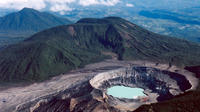Poas Volcano National Park Tour From San Jose
San Jose, Costa Rica
Trip Type: Day Trips
Duration: 5 hours
Poás Volcano is one of the major attractions in the Central Valley region, one of the most visited national parks, and a great day trip add-on for any Costa Rica vacation itinerary.
More About This Activity All Day Trips →
Poás Volcano is one of the major attractions in the Central Valley region, one of the most visited national parks, and a great day trip add-on for any Costa Rica vacation itinerary.This tours stars taking the Pan-American Highway towards the city of Alajuela. In route you will go visit the Agriculture Monument, the Monument to Juan Santamaria and the famous Mango Park. As you ascend towards the volcano you will stop for a brief explanation about coffee beans, and then continue your trip through fern, flower and strawberry farms.
There is a noticeable change in temperature and vegetation, preparing you for the pleasure of the exuberant cloud forest of Poas Volcano.
At the Volcano you will have time to enjoy the impressive main crater with its sulfur fumaroles, and hike on a trail to the beautiful Botos Lagoon as you learn about the different ecosystems in the park.
Poás is active, but don’t expect to see a full fledged eruption or even any lava flow here, the most recent period of eruptive activity ended in 1954. The last major activity was in 1910 when nearly a million tons of ash was ejected along with an immense column of smoke and steam.The volcano provides an excellent if extreme example of the effects of acid rain. Around the caldera, and for several miles downwind, the vegetation is stunted brown and black by the tainted moisture that precipitates from the omnipresent clouds near the peak.
Poás is above the frost line, and temperatures below freezing are possible. Nearly constant winds and saturating humidity contribute to biting cold at the rim.
There is a noticeable change in temperature and vegetation, preparing you for the pleasure of the exuberant cloud forest of Poas Volcano.
At the Volcano you will have time to enjoy the impressive main crater with its sulfur fumaroles, and hike on a trail to the beautiful Botos Lagoon as you learn about the different ecosystems in the park.
Poás is active, but don’t expect to see a full fledged eruption or even any lava flow here, the most recent period of eruptive activity ended in 1954. The last major activity was in 1910 when nearly a million tons of ash was ejected along with an immense column of smoke and steam.The volcano provides an excellent if extreme example of the effects of acid rain. Around the caldera, and for several miles downwind, the vegetation is stunted brown and black by the tainted moisture that precipitates from the omnipresent clouds near the peak.
Poás is above the frost line, and temperatures below freezing are possible. Nearly constant winds and saturating humidity contribute to biting cold at the rim.
« Go Back

